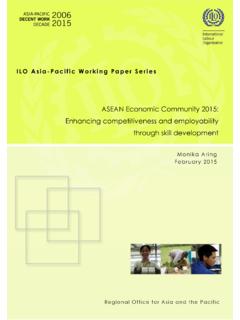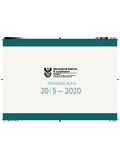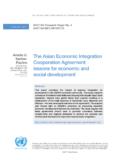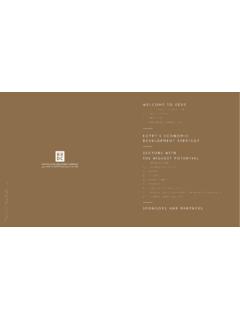Transcription of Sudan Plan of Action (2015-2019) - Summary
1 UNAMID Sudan plan OF Action ( 2015 -2019) Summary UNAMID THE CONTEXT Population of Sudan : million Two-thirds of the total population live in rural areas and 58 percent are poor * 2 million children are suffering from acute malnutrition 500 000 children are severely acutely malnourished** million Internally Displaced People (IDPs), of which million IDPs are in Darfur More than 250 000 refugees** Widespread conflicts over ownership and use of natural resources among pastoralists, agropastoralists and crop farmers. Land tenure practices and conversion of range and forest land into large mechanised farming is also a source of conflict. Conflicts continue in border areas with South Sudan . THE AGRICULTURE SECTOR Sources (*FAO, **FSL-HRP 2015 , **WHO, **OCHA) Rainfed agriculture: Semi-mechanised rainfed farming; Traditional rainfed farming; Livestock production.
2 Large scale irrigation Fisheries and forestry Nearly one-third of the GDP comes from Agriculture. More than one-third of the national workforce is engaged in agriculture and agroprocessing industries. THE HUMANITARIAN RESPONSE plan FOR 2015 80 percent ( million) of million people targeted for humanitarian assistance under the Humanitarian Response plan (HRP) for 2015 are food insecure. USD 357 002 165 is pledged by the Food Security and Livelihoods (FSL) Sector co-led by FAO and WFP**. USD 291 318 389 (82 percent) is pledged by the FSL for food assistance and USD 65 683 776 (18 percent) is for food production and other livelihoods assistance. Current Strengths Vast areas of cultivable agricultural land Sufficient water resources to meet agricultural requirements Huge livestock resource potential and sizeable fish resources Network of agricultural faculties across the country in all agricultural specializations Generations of trained manpower Adoption of federal system of government encourages participation of local authorities Planned improvement of rural infrastructure to encourage free-market mechanisms Strategic geographical location in Neat East and North Africa region Commitment and political will for sustainable socio-economic rural development Current Weaknesses (opportunities for change) Fragile state of national economy Low levels of crops, livestock, fisheries and forestry productivity Outdated agriculture and natural resources policies.
3 And lack of policy coordination Agricultural plans lack scientific and operational approaches Weak agricultural research and extension services Poor condition of existing rural infrastructure (lack of public and private investment) Lack of capacity to produce agricultural equipment and inputs locally Lack of quality control, and sanitary, phytosanitary and food safety procedures Lack of strict measures to apply regional and international agreements Weak linkages between stakeholders affects smallholder pastoralists, fishers and tree- dependent communities Deep-rooted rivalries between professional and trade union organizations Insecurity and tenuous peace, especially in areas of high potential for agricultural production Potential Threats Rapid population growth Continuous deterioration of the country s natural resource base Escalation of political and tribal conflicts 85 percent of animal resources depend on pastoral and transhumant systems of production Increasing risk of transboundary plant and animal pests and diseases Climate change and variability ( dry spells, droughts, heavy rainstorms, floods, etc.)
4 Institutions and procedures that control public funds not suitable for financing agriculture Trade barriers of developed countries/potential markets limit access to Sudanese exporters Soaring prices of food and agricultural inputs T 3 Potential Opportunities Realisation of peace and stability Possibility of increased oil and gold production to finance infrastructure and manufacturing Change towards a more open economy Public awareness that agriculture is the main source of rapid and balanced economic growth Potential for more efficient utilization of Sudan s share of River Nile waters Application of small- and large-scale water- harvesting technologies Utilization of forward and backward linkages between agriculture and industry (value chains) Strategic location of Sudan for agricultural trade (vis vis Near East, North Africa and Europe) he Government of Sudan has advocated agriculture as the FAO/ Sudan engine to effectively contribute to economic growth and export performance and to simultaneously advance people s livelihoods, reduce poverty, improve food security and nutrition and develop and protect natural resources FAO S GOOD PRACTICE IN Sudan S AGRICULTURE SECTOR Over the last ten years, several good practices have been tested and validated by the actors and beneficiaries of FAO s humanitarian relief, livelihood protection/recovery and agricultural development programmes, and are recommended for replication and up-scaling by government agencies and civil society organizations (CSOs).
5 These include: Capacity development of government institutions and CSOs. Food security information systems for food security decision making and policy development. Control of transboundary plant and animal pests and diseases. Community-based animal resources development services. Farmer field school group-based approach to adaptive research and participatory extension. Community-based natural resource management. Water harvesting and on-farm water management. Post-harvest management, as part of an integrated value chain approach. Voluntary guidelines on the responsible governance of tenure of land in the context of food security (VGGT). Resource mobilization, implementation and operations for emergency relief food security and livelihood protection interventions. Sudan COUNTRY PROGRAMMING FRAMEWORK (2012 2016) The Sudan Country Programming Framework (CPF) is co-owned by FAO and the Government of Sudan , though its Ministries of Agriculture and Irrigation; of Livestock, Fisheries and Rangelands; of Environment, Forestry and Physical Development; and of Water Resources and Electricity.
6 It presents the broad commitment of FAO, subject to the availability of the required funding, to assist the Federal and State Governments in their efforts to achieving their own national and state development objectives that are specific to: Agriculture Food and nutrition security Natural resource management Capacity development and consolidation of policy, laws, planning and information 1 institutions, systems and mechanism reforms and development in agriculture, fisheries and forestry of Sudan . 2 CPF STRATEGIC PRIORITIES 3 Capacity development of agricultural research, technology and knowledge development and transfer for enhanced productivity, production and competitiveness institutions, systems and mechanisms in agriculture, fisheries and forestry of Sudan . Capacity development of natural resources conservation and management institutions, systems and mechanisms in agriculture, forestry and fisheries of Sudan .
7 Capacity building of drought risk management institutions, systems and mechanisms in 4 agriculture, forestry, and fisheries of Sudan . FAO/ Sudan T FAO plan OF Action FOR Sudan ( 2015 2019) Resilient Livelihoods for Sustainable Agriculture, Food Security and Nutrition OVERALL GOAL: o contribute to the improvement of food security and nutrition and the reduction of rural poverty in Sudan , while supporting the country s longer-term economic development goals . FOUR STRATEGIC MULTISECTORAL INTERVENTIONS The plan of Action (PoA) prioritizes and promotes interrelated and mutually supporting and sustainable short-, medium- and long-term interventions at all levels ( household, community and institutional) in support of the relief, recovery and development of Sudan s small-scale agriculture sector and to address and 5 overcome the underlying causes of vulnerability in Sudan .
8 Crosscutting activities across the four strategic interventions: Stakeholder capacity development Food-based nutrition Gender equality Peace and stability building 17 Projects Strategic Partnerships FAO facilitates partnerships for the implementation of food and nutrition security and agricultural and rural development interventions with: Government institutions and local authorities Civil society The private sector South-South Cooperation Development partners Food and nutrition security and livelihood protection and short-term risk-sensitive agricultural policy/strategy development. Risk-sensitive research and development and institutional strengthening of the agriculture sector. Rural livelihoods recovery and risk- sensitive agricultural and rural development. Total Cost Estimate: USD million FAO FAO/ Sudan UNAMID INTERVENTION AREAS, PROGRAMMES AND PROJECTS OF THE FAO CPF/POA 1.
9 Improved Policy and Institutional Environment for Food and Nutrition Security and Resilience Programming through capacity development, enhanced coordination and better informed decision making and knowledge management and sharing systems SN Track Programme/Project Brief Duration Cost (USD) Short-term project Capacity development of agricultural decision makers and support services to promote international best practice in research and extension, climate-smart agriculture and integrated food nutrition under reformed agriculture, food security and nutrition policies and strategies 18 months 500 000 Short-term project Support to disaster risk reduction (DRR) and crisis management in the agriculture sector resulting in a functioning multistakeholder platform for DRR and crisis management for agriculture, food security and nutrition-related subsectors 24 months 500 000 Long-term programme Capacity development for evidence-based resilience and food security and nutrition policy and programmes up-scaling of current FSPS Programme 60 months 27 800 000 Medium-term project National forest resource assessment and monitoring capacity development of Forests National Corporation for data collection, analysis and dissemination 36 months 3 200 000 Short-term project Support to process development in the forestry sector including National Action plan for regional Great Green Wall, preparedness for a national REDD+ strategy and follow-up on FAO Committee on Forestry (COFO)
10 Multi-Year Programme 18 months 500 000 Short-term project Defining a role for private sector service providers to support smallholder farmers in a reformed agriculture sector including capacity development of the Union of Chambers of Agriculture and Production (of the Sudanese Businessmen and Employers Federation) 12 months 156 000 Long-term programme (of annual HRP funding) Coordination of the United Nations Food Security and Livelihood Cluster (Humanitarian Needs Overview and Humanitarian Response plan ), DFA/DDS s Economic Recovery Pillar III, and contribution to a revised UNDAF 60 months (5 yrs x 12) 2 500 000 2. Enhancing Production, Productivity and Competitiveness of the Crops, Livestock and Forestry Subsectors and Agricultural Climate Change Adaptation SN Track Programme/Project Brief Duration Cost (USD) Short-term project Climate change adaptation in key rainfed food crop, fodder crop and pasture varieties development of drought and heat-tolerant groundnut, legumes, maize, millet, sesame, sorghum, sunflower and nutritious grasses 24 months 3 600 000 Medium-term project Expansion of a quality seed production system (with value addition for smallholder farm and community-level seed multiplication)
















